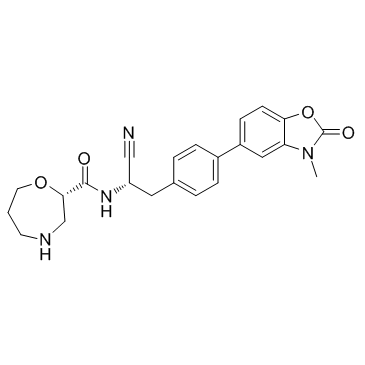| Description |
AZD7986 is a Dipeptidyl peptidase 1 (DPP1) inhibitor with pIC50s of 6.85, 7.6, 7.7, 7.8, and 7.8 in human, mouse, rat, dog and rabbit, respectively.
|
| Related Catalog |
|
| Target |
pIC50: 6.85 (human DPP1), 7.6 (mouse DPP1), 7.7 (rat DPP1), 7.8 (dog DPP1), 7.8 (rabbit DPP1)[1]
|
| In Vitro |
Results from cell assay show that AZD7986 is a Dipeptidyl peptidase 1 (DPP1) inhibitor with pIC50s of 6.85, 7.6, 7.7, 7.8, and 7.8 in human, mouse, rat, dog and rabbit, respectively. AZD7986 is stable in the propionaldehyde reactivity assay, with a half-life over 50 h. After differentiation in the presence of AZD7986 (38 pM to 10 μM), concentration-dependent decreases in cell lysate enzyme activity are observed for DPP1, as well as for all of the three NSPs, NE, Pr3, and CatG. AZD7986 inhibits activation of all three NSPs in a concentration dependent manner, with pIC50 values of around 7 for all three NSPs. The reduction of the activities is almost complete, with NE, Pr3, and CatG activities reduced to 4 to 10% of control at 10 μM AZD7986[1].
|
| In Vivo |
AZD7986 shows good stability in plasma, with a half life of >10 h. AZD7986 inhibits activation of NE and Pr3, but not CatG, in bone marrow cell lysates in a dose dependent manner in vivo[1].
|
| Kinase Assay |
Activation of neutrophil serine proteases (NSPs) is assessed in vitro using primary bone marrow derived CD34+ neutrophil progenitor cells. Cells are cultured in media supplemented with rhSCF and rhIL-3 for 7 days, and then for a further 7 days in the presence of G-CSF and different concentrations of AZD7986 (38 pM to 10 μM). After harvesting and lysis with 10% Triton X-100 buffer, cell lysates are kept at -20°C until NSP activity analysis[1].
|
| Cell Assay |
Cellular potency is studied using the DPP1-expressing monocytic U937 cell line. Briefly, cells grown in RPMI are plated on 384-well polypropylene v-bottom plates at a density of 5×105 cells/mL per well. Added to this is 10 μL of AZD7986 at 37°C for 60 min, followed by 350 μM Gly-Phe-AFC. The well fluorescence is read using a multilabel plate reader. Data are analyzed to calculate pIC50 values[1].
|
| Animal Admin |
Rats are used for the in vivo study. Naive rats are dosed orally twice daily with AZD7986 at 0.2, 2, and 20 mg/kg/day for 8 days. Attermination, bone marrow is taken by femural aspiration for neutrophil serine proteases (NSPs) activity analysis using commercial synthetic peptide substrates[1].
|
| References |
[1]. Doyle K, et al. Discovery of Second Generation Reversible Covalent DPP1 Inhibitors Leading to an Oxazepane Amidoacetonitrile Based Clinical Candidate (AZD7986). J Med Chem. 2016 Oct 27;59(20):9457-9472.
|
